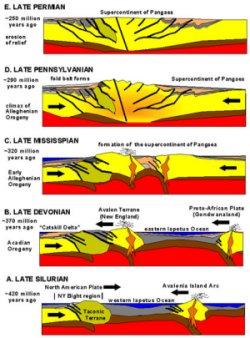
The
Appalachian Orogeny is an excellent example of a mountain
building event resulting from tectonics. The Appalachian
Orogeny resulted from three separate continental collisions
formed the Appalachian Mountains and Allegheny Mountains
at the end of the Paleozoic. The combined continents
of Europe and Africa (Gondwana) collided with North
America to form the supercontinent of Pangaea approximately
350 million to 300 million years ago during the Carboniferous
period. The collision exerted enormous stress on what
today is eastern North America, an causing an enormous
upward thrusting of the entire region. The tectonic
stresses also metamorphosized of the rock from igneous
and sedimentary rock into metamorphic rock. These stresses
concurrently caused faults (mostly thrust faults and
some strike-slip faults) as well as folding. It is believed
that the Appalachians once could have risen as high
as or even higher than the Himalaya (i.e., more than
4 ½ miles high). These mountains, while still
impressive in places, are mere remnants of their glory
days during the Paleozoic. They have been worm away
by the relentless forces of erosion, forming vast amount
of sediments in the process. Carbonates and sediments
from mountains formed in the
Appalachian
Orogeny were away to form limey rocks in a shallow
sea that was later uplifted and now forms the majority
of Tennessee, Kentucky,
Indiana
and Ohio.

